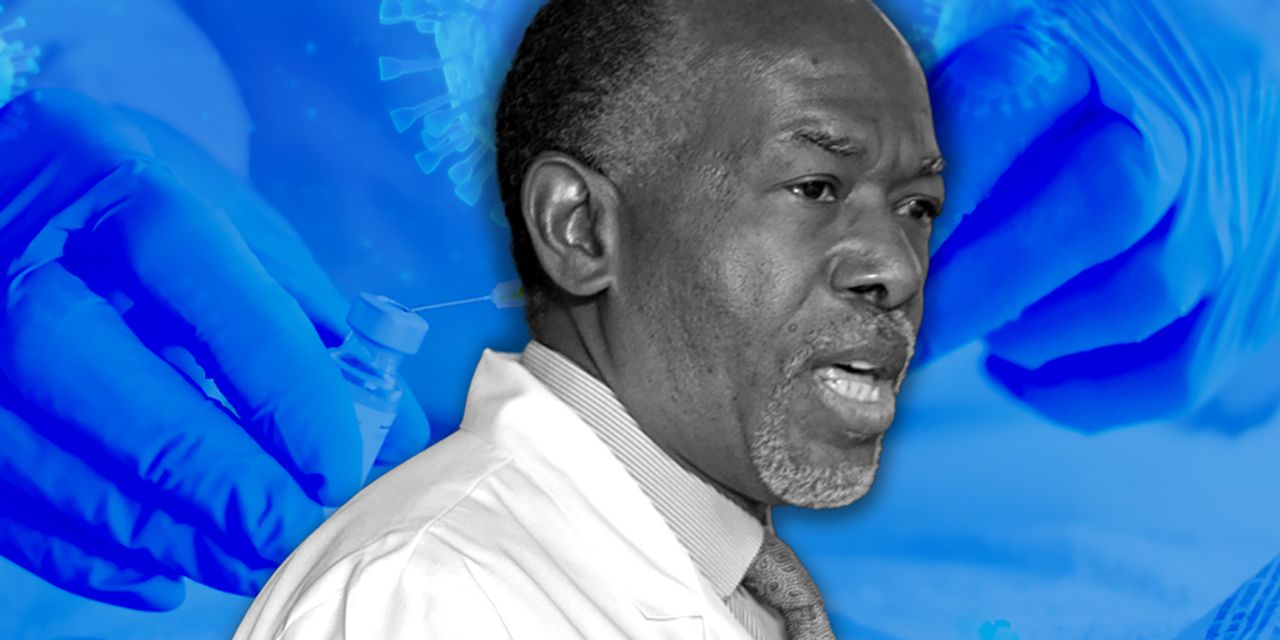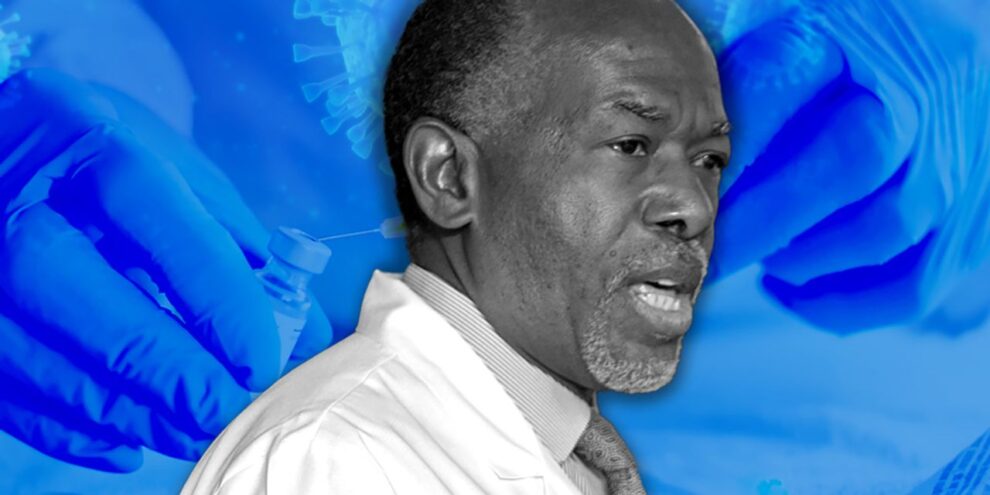
This interview is part of a series of conversations MarketWatch is conducting with some of the leading voices in the U.S. on the COVID-19 pandemic.
Dr. James Hildreth is a longtime HIV researcher who is now running Meharry Medical College, one of the nation’s four historically black medical colleges.
He’s also the first volunteer in the upcoming Phase 3 clinical trial for Novavax Inc.’s NVAX, +10.64% experimental COVID-19 vaccine. The trial, which has been slowed by requests from U.S. regulators and counts Meharry as one of its study sites, is expected to begin this month.
“I want to demonstrate that I’m doing what I’m asking other people to do, that I’m confident enough in the safety” of vaccines, Hildreth said last week.
Two months ago he was asked to join the Food and Drug Administration’s advisory committee on vaccines, which is made up of a group of independent medical experts who met twice this month to weigh in on whether the regulator should authorize BioNTech BNTX, -0.50% and Pfizer Inc.’s PFE, +1.91% vaccine, as well as one from Moderna Inc.’s MRNA, +3.54%. (The FDA has now granted emergency-use authorizations to both mRNA-based vaccines, with Pfizer’s announced on Dec. 11 and Moderna’s on Dec. 18, following favorable opinions from the committee.)
That both vaccines were authorized within a year of development should be “viewed as one of the great triumphs of science,” Hildreth said.
But what’s next may be even more challenging. Hundreds of millions of people in the U.S. need to be vaccinated (and in some cases may need to be convinced to be vaccinated). Hildreth wants it to be clear to the general public that reactions to vaccines are common, and for the most part nothing to be scared of, and that communities of color, many of which have a history of distrust the medical establishment, need trusted ambassadors to educate them about COVID-19 vaccines and vaccination.
This may include some people of color, including African Americans, who have disproportionately had to deal with a history of medical mistreatment and still can face medical bias and gaslighting because of their race.
“Given all that has transpired over the last 400 years, we have got to make sure they have a sense of agency, that they are empowered to make the decision for themselves,” he said.
MarketWatch: What are your biggest concerns about either of these vaccines?
Dr. James Hildreth: All of us had a shared concern that we wish there could have been a longer follow-up. [It was] two months. But there’s a little bit of comfort in knowing that for most vaccines that are newly introduced, if there’s going to be some really bad adverse consequences, it tends to happen within the first six weeks. Between Pfizer and Moderna, we have tens of thousands of people who were followed for at least that long.
I try to explain to people that vaccines are getting the attention of your immune system, and when that happens, there are certain things we can expect, and those are the kinds of things that we did see in the volunteers.
MarketWatch: That was actually something I was going to ask you about, specifically the allergic reactions that have been reported with the Pfizer vaccine in the U.K. and Alaska.
Hildreth: It’s not entirely unexpected, because we’ve seen this in past vaccines. People need to understand that there’s a robust and comprehensive tracking system to make sure … [reactions] can quickly be identified, and they’re being investigated to try to determine what prompted the allergic reaction. But all of the things that are in the vaccines are pretty well-known. There are no animal products. There are no preservatives. It’s some inorganic salts from lipids, and the mRNA itself. The mRNA is not going to be the culprit, because mRNA has been injected into people and animals for a couple of decades now.
We know that in all of these individuals there was a past history of severe allergies. What happens in those cases, you make sure that when you give a vaccine, you give it in a setting where you [can] promptly treat a reaction like that, and that’s what happened in these cases. I think those folks are going to be OK.
MarketWatch: How do you talk to members of the general public who are trying to understand the risks of taking a vaccine like this versus being willing to take it and understanding the normal side effects that can occur?
Hildreth: You need to know that there probably will be a reaction to the vaccine. There might be some swelling. The headache, the muscle aches, all those things are to be expected. But I think people need to know that, so they’re not surprised when they happen. We’ve got to do a good job of conveying that.
The other thing that has been mentioned, the Bell’s palsy, where you get facial paralysis. Even that doesn’t warrant alarm, because that’s not above the expected frequency in the general population.
The other thing that’s a concern for people is what they view as a really rapid process. And it is true that most vaccines have taken a long time, the fastest one that I know of is Ebola, [which took] four years or seven years, depending on how you look at it. Here’s something that’s happened in 11 months. There are a lot of reasons for that, most of which are related to the science and scientific advances.
MarketWatch: Do you see any clear, major differences between the Moderna and Pfizer vaccines? I realize they’re both mRNA-based, and there’s the exception of the indication difference on teens, but I was curious if there’s anything else that really stood out. (The FDA authorized BioNTech and Pfizer’s vaccine to be used in anyone who is at least 16 years old. The Moderna vaccine is only authorized for adults.)
Hildreth: It’s quite satisfying that [there are] two vaccines based on the same platform, with the same targets. If Pfizer had a four-week interval or if Moderna had a three-week interval, it wouldn’t matter because the point is you’re priming and boosting. What’s remarkable is there were about the same number of participants. You saw numbers that are virtually superimposable, in terms of efficacy, the reactions that people have. [Editor’s note: Both vaccines had an efficacy rate of about 95% in clinical trials.] So, that adds even more confidence, from my point of view, that we have sufficient data. If it hadn’t turned out that way, I would be a little bit concerned.
MarketWatch: Why do you think it’s important to have multiple vaccine options?
Hildreth: We have to vaccinate more than seven and a half billion people. Depending on the continent, it’s very hard to quickly deploy the Pfizer vaccine in some settings, because not every place has the facility to store.
MarketWatch: Meaning the cold-chain storage requirements.
Hildreth: Yes. So we need a vaccine or two that are stable, hopefully at room temperature, that can be administered under conditions that are not ideal. That’s really one of the reasons why Operation Warp Speed was pushing for three different platforms.
MarketWatch: In the U.S., it sounds like that same thinking could apply to people in very rural communities versus those in cities.
Hildreth: Absolutely.
MarketWatch: Moderna and Pfizer were publicly tracking different races of the participants in the Phase 3 clinical trials for their vaccines. Do you think that the vaccines were tested in enough people of color?
Hildreth: Well, yes, and no. In both trials, about 10% of the participants were Black or African American. And in both trials, more than 20% were Hispanic. I wish the number of African Americans had been higher. Ten percent is the bare minimum. The thing that kind of makes up for that is 40% or more in both [studies] were individuals who have chronic underlying conditions. That was one of the main reasons I wanted minorities included because they have these chronic conditions. But it turns out that across the whole enrollment of participants, at least 40% had one of these conditions that we are so concerned about, including in Moderna’s case a third of that participants were obese. I think the companies did a good job.
MarketWatch: Why did you decide to enroll in the Novavax trial?
Hildreth: Because I want to demonstrate that I’m doing what I’m asking other people to do, that I’m confident enough in the safety. I’m very encouraged that around the country, health care providers, elected officials, and others who are respected in the community, they are doing the same. This is necessary to instill confidence in the general public, that this is something that’s safe to do.
MarketWatch: What are the best ways to ensure that African-American and Latinx people feel safe enough to receive these vaccines?
Hildreth: Given all that has transpired over the last 400 years, we have got to make sure they have a sense of agency, that they are empowered to make the decision for themselves. The goal is to make sure that people understand as much as [what] we can provide them: what vaccines are, how they work, what is and is not true about them.
We also want to make sure that we identify [what] I call “trusted messengers,” people who are respected and trusted in communities, to have them be the ones who are leading some of their conversations. That means we’ve got to empower them with the knowledge they need to be that liaison to the community. But to me it really comes down to giving people enough information that they can understand that they feel comfortable making the decision. And we have got to acknowledge that there’s justification for their hesitancy.
Unlike past drug development and vaccine development, African Americans and people of color have been involved in every aspect of this. The lead scientist [the National Institutes of Health’ Kizzmekia Corbett] is Black, I sat on the committee that reviewed vaccines for the FDA, 10% of the participants of the trials were Black.
MarketWatch: You recently tweeted that teachers should be on the priority list for vaccines.
Hildreth: I agree with some elected officials that restarting the economy is critical, because people need to work and provide for their families. But one thing is obvious is that opening schools is key to opening the economy. When parents stay home and teach their kids, and some of them don’t have the wherewithal and technology to do so, that is a huge impediment to fully reopening the economy.
And also, we know now that for the most part children are not going to be harmed by COVID-19, [though] I still have some concerns about long-term.
Teachers and staff are not in that same category. And many of them have underlying conditions that might put them at risk for severe disease. If you want to safely reopen the schools, which is key to reopening the economy, teachers should be [high] on the list to get vaccinated, right along with essential workers.
This Q&A has been edited for clarity and length.
Read more A Word from the Experts interviews:
• Dr. Zeke Emanuel says this is what it will take to fully reopen the U.S.











Add Comment